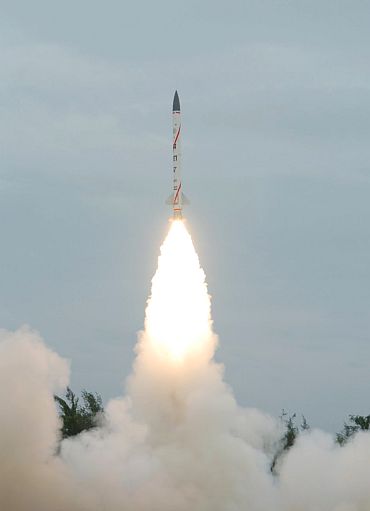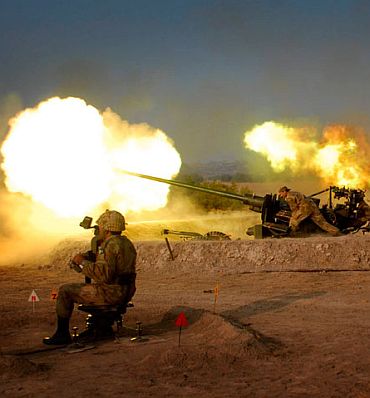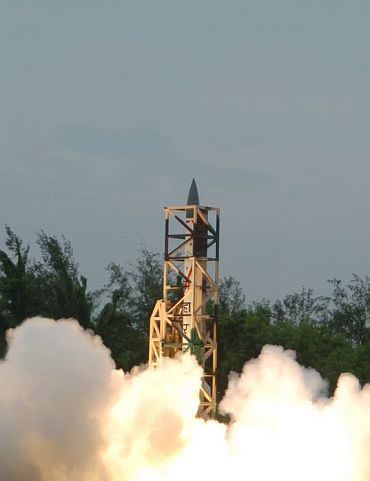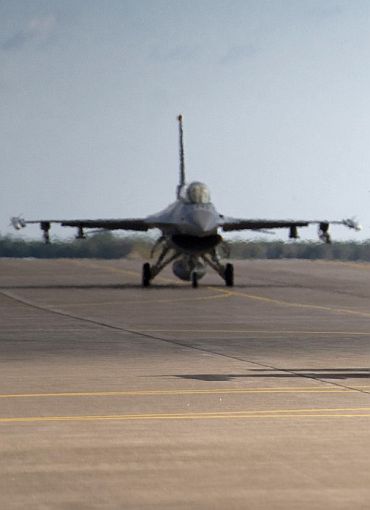Ajai Shukla in New Delhi
India's ability to win a quick, pre-emptive war against Pakistan has just been enhanced by a useful new set of teeth.
On July 22 morning, at a missile test range in Balasore, Orissa, the Defence Research and Development Organisation launched its first-ever Prahaar missile, a mobile, truck-mounted rocket that can strike within 10 metres of a target that is 150 kilometres away.
The Prahaar gives a huge boost to India's military doctrine of 'Cold Start'.
This method of war would be adopted as retaliation for any grave Pakistani provocation, such as another 26/11 Mumbai-style terror attack.
...
Prahaar is categorised as a battlefield tactical missile
Cold Start involves multiple, simultaneous invasions of Pakistani territory with quickly assembled Indian Army battle groups, well before Pakistani forces can reach the border and occupy defensive positions.
The Prahaar would provide the army's invading battle groups with lethal fire support, striking Pakistani headquarters far behind the frontlines, and destroying roads, railways, bridges and other communications infrastructure that are essential for rushing Pakistani forces to the border.
Unlike the DRDO's Prithvi missile, which was introduced into service as a 150-kilometre range, nuclear-capable ballistic missile, the Prahaar is categorised as a "battlefield tactical missile".
Its maximum payload of 200 kg does not allow the Prahaar to carry a nuclear weapon (which are seldom under 500 kg). But while nuclear capable ballistic missiles are useful only in the nightmarish eventuality of nuclear war, the Prahaar can be useful at every stage of a Cold Start campaign.
Prahaar's range of warheads gives the Indian Army multiple options
Being a solid-fuel missile, it can swing into action quickly in response to rapidly evolving situations; and its short flight time -- just 250 seconds, or just over four minutes -- allows it to engage fleeting targets that would disappear in the time that it would take to scramble and fly in fighter aircraft.
Furthermore, the Prahaar's range of warheads, which the DRDO has developed, gives the Indian Army multiple options. It could carry a cargo warhead containing bomblets that disperse over a wide area, killing any exposed troops.
Alternatively, it could carry air-delivered mines, which spread across a piece of terrain, denying passage to enemy infantry or tanks. Or the Prahaar could carry a single, high explosive warhead that can demolish even the best-protected target or critical infrastructure.
Pakistan has no battlefield missile similar to the Prahaar
So far, many of these targets have fallen to the lot of the Indian Air Force. But in a Cold War situation the emphasis of the IAF, especially during the initial crucial days, would focus on attacking the Pakistan Air Force to prevent it from causing casualties in the Indian Army's attacking battle groups, or stopping their advance.
By using the Prahaar against enemy entities that are beyond the range of artillery guns or rockets (30-40 kilometres); or for interdicting enemy reserves and logistic columns far behind the lines, IAF fighters would be freed up for 'counter-air operations' against the PAF.
If, as is more than likely, the IAF buys the Prahaar in numbers, the missile could be effectively launched against forward Pakistani air bases, destroying fighters on the ground and damaging runways, air defence radars and air control networks.
Currently, manned fighter aircraft perform these tasks, often at the cost of pilots' lives and shot down fighters. Pakistan has no battlefield missile similar to the Prahaar.Pakistan's scientists have focused on developing the Hatf-9
Over recent years, Pakistan's scientists have focused on developing the Hatf-9 (or Nasr) short range, ballistic missile, which seeks to deter a Cold Start campaign with its ability to deliver a nuclear warhead to a maximum distance of 60 kilometres.
Since most Indian cities are farther than that, strategists believe that the Hatf-9 is intended for counter-force targeting, i.e. against one or more of the Indian Army's integrated battle groups inside Pakistani territory.
This would serve notice of Pakistani resolve to carry out a counter-value strike, which would take the form of a longer-range missile, carrying a nuclear warhead to one or more large Indian cities.
Prahaar is comparable to the US Army's ATACMS
Image: US Army's Advanced Tactical Missile SystemAccording to the DRDO, the Prahaar is comparable to the US Army's Advanced Tactical Missile System (ATACMS), which was extensively used during the invasion of Iraq in 2003.
The Prahaar is launched from a Road Mobile System developed by Larsen & Toubro, which can carry six missiles.
All six can be fired in a salvo, each of them against a different target.
According to the DRDO, the Prahaar was developed in a period of just two years.








article